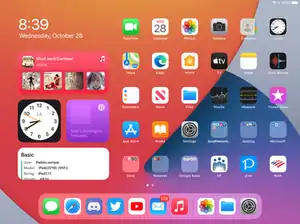iPadOS
iPadOS is a mobile operating system created and developed by Apple Inc. for its iPad line of tablet computers. It is a rebranded variant of iOS, the operating system used by Apple's iPhones, renamed to reflect the diverging features of the two product lines, particularly the iPad's multitasking capabilities and support for keyboard use. It was introduced as iPadOS 13 in 2019, reflecting its status as the successor to iOS 12 for the iPad, at the company's 2019 Worldwide Developers Conference.[10] iPadOS was released to the public on September 24, 2019. The current version is iPadOS 14.4, released on January 26, 2021.
 iPadOS 14 home screen in running on an iPad (2019) | |
| Developer | Apple Inc. |
|---|---|
| Written in | C, C++, Objective-C, Swift, assembly language |
| OS family | Unix-like, based on Darwin (BSD), iOS |
| Working state | Current |
| Source model | Closed with open-source components |
| Initial release | September 24, 2019[1] |
| Latest release | 14.4[2] (18D52)[3] (January 26, 2021) [±] |
| Latest preview | 14.5 beta[4] (18E5140k)[5] (February 4, 2021) [±] |
| Marketing target | Tablet computers |
| Available in | 40 languages[6][7][8][9] |
| Update method | OTA, Software Update, App Store |
| Platforms | iPads with ARMv8-A CPUs |
| Kernel type | Hybrid (XNU) |
| Default user interface | Cocoa Touch (multi-touch, GUI) |
| License | Proprietary software except for open-source components |
| Preceded by | iOS |
| Official website | www |
| Support status | |
| Supported | |
| Articles in the series | |
| iOS (derived from) | |
History
The first iPad was released in 2010 and ran iPhone OS 3.2, which added support for the larger device to the operating system, previously only used on the iPhone and iPod Touch. This shared operating system was rebranded as "iOS" with the release of iOS 4.[11]
The operating system initially had rough feature parity running on the iPhone, iPod Touch, and iPad, with variations in user interface depending on screen size, and minor differences in the selection of apps included.[12] However, over time, the variant of iOS for the iPad incorporated a growing set of differentiating features, such as picture-in-picture, the ability to display multiple running apps simultaneously (both introduced with iOS 9 in 2015), drag and drop, and a dock that more closely resembled the one in macOS than the one on the iPhone (added in 2017 with iOS 11). Standard iPad apps were increasingly designed to support the optional use of a keyboard.
To emphasize the different feature set available on the iPad, and to signal their intention to develop the platforms in divergent directions, at WWDC 2019, Apple announced that the variant of iOS that runs on the iPad would be rebranded as "iPadOS". The new naming strategy began with iPadOS 13.1, in 2019.[10]
On June 22, 2020, at WWDC 2020, Apple announced iPadOS 14, with compact designs for search, Siri, and calls, improved app designs, handwriting recognition, better AR features, enhanced privacy protections, and app widgets.[13] iPadOS 14 was released to the public on September 16, 2020.
Features
Many features of iPadOS are also available on iOS; however, iPadOS contains some features that are not available in iOS and lacks some features that are available in iOS.
Home Screen
Unlike previous versions of iOS, the icon grid displays up to five rows and six columns of apps, regardless of whether the device is in portrait or landscape orientation. The first page of the home screen can be configured to show a column of widgets from applications for easy access. Spotlight Search is no longer part of the widgets but can still be accessed by swiping down from the center of the home screen or pressing Command + Space on a connected keyboard.
Multitasking
iPadOS features a multitasking system developed with more capabilities compared to iOS, with features like Slide Over and Split View that make it possible to use multiple different applications simultaneously. Double-clicking the Home Button or swiping up from the bottom of the screen and pausing will display all currently active spaces. Each space can feature a single app, or a Split View featuring two apps. The user can also swipe left or right on the Home Indicator to go between spaces at any time, or swipe left/right with four fingers.
While using an app, swiping up slightly from the bottom edge of the screen will summon the Dock, where apps stored within can be dragged to different areas of the current space to be opened in either Split View or Slide Over. Dragging an app to the left or right edge of the screen will create a Split View, which will allow both apps to be used side-by-side. The size of the two apps in Split View can be adjusted by dragging a pill-shaped icon in the center of the vertical divider and dragging the divider all the way to one side of the screen closes the respective app. If the user drags an app from the dock over the current app, it will create a floating window called Slide Over which can be dragged to either the left or right side of the screen. A Slide Over window can be hidden by swiping it off the right side of the screen, and swiping left from the right edge of the screen will restore it. Slide Over apps can also be cycled between by swiping left or right on the Home Indicator in the Slide Over window and pulling up on it will open an app switcher for Slide Over windows. A pill-shaped icon at the top of apps in Split View or Slide Over allows them to be switched in an out of Split View and Slide Over.
The user can now have several instances of a single app open at once. A new Exposé mode has been added which allows the user to see all of the instances of an app.[14]
In many applications, a notable exception being YouTube, videos can be shrunk down into a picture-in-picture window so the user can continue watching it while using other apps. This window containing the video can be resized by pinching and spreading and can be docked to any of the four corners of the screen. It can also be hidden by swiping it off the side of the screen and is denoted by an arrow at the edge where the video is hidden and swiping it will bring it back onscreen.
Safari
Safari now shows desktop versions of websites by default, includes a download manager, and has 30 new keyboard shortcuts if an external keyboard is connected.[15][16][17][18]
Sidecar
Sidecar allows for an iPad to function as a second monitor for macOS, named in reference to articulated motorcycles. When using Sidecar, the Apple Pencil can be used to emulate a graphics tablet for applications like Photoshop.[19] This feature is only supported on iPads that support the Apple Pencil. However, earlier versions of iPadOS 13 allowed all iPads compatible with iPadOS 13 to work with Sidecar.
Storage
iPadOS allows external storage, such as USB flash drives, portable hard drives, and solid state drives to be connected to an iPad via the Files app. The iPad Pro (3rd generation) connects over USB-C, but the Lightning camera connection kit also works to connect external drives with previous iPads.[20]
Mouse and trackpad support
Mouse and trackpad support was added in version 13.4.[21]
Scribble
Introduced in iPadOS 14, Scribble converts text handwritten by an Apple Pencil into typed text in any text field.[22]
References
- "iPadOS". Apple Inc.
- Clover, Juli (January 26, 2021). "Apple Releases iOS 14.4 and iPadOS 14.4 With New Camera Warnings and Bug Fixes". MacRumors. Retrieved January 26, 2021.
- "iPadOS 14.4 (18D52) - News - Apple Developer". Apple Developer. Apple Inc. January 26, 2021. Retrieved January 26, 2021.
- Clover, Juli (February 4, 2021). "Apple Seeds Updated First Beta of iOS 14.5 and iPadOS 14.5 to Developers and Public Beta Testers". MacRumors. Retrieved February 4, 2021.
- "iPadOS 14.5 beta (18E5140k) - News - Apple Developer". Apple Developer. Apple Inc. February 4, 2021. Retrieved February 4, 2021.
- "Apple – iPad Pro – Specs". Apple Inc. Archived from the original on January 4, 2019. Retrieved January 4, 2019.
- "Apple – iPad mini 4 – Specs". Apple Inc. Archived from the original on October 24, 2015. Retrieved October 24, 2015.
- "Apple – iPad Air 2 – Technical Specifications". Apple Inc. Archived from the original on October 26, 2015. Retrieved October 24, 2015.
- "Apple – iPhone XS – Technical Specifications". Apple Inc. Archived from the original on January 4, 2019. Retrieved January 4, 2019.
- Wuerthele, Mike (June 3, 2019). "Apple unveils iPadOS, adding features specifically to iPad". AppleInsider. Retrieved June 3, 2019.
- Tartakoff, Joseph (June 7, 2010). "Apple Avoids iPhone-Like Trademark Battle Thanks To Cisco, FaceTime Deals". paidContent. Archived from the original on May 11, 2011. Retrieved February 2, 2011.
- "Why the iPad has never shipped with a calculator app". Cult of Mac. April 7, 2016. Retrieved May 3, 2020.
- "iPadOS 14 introduces new features designed specifically for iPad" (Press release). Cupertino, California: Apple Inc. June 22, 2020. Retrieved September 29, 2020.
- "iPadOS lets you open multiple instances of the same app for powerful multitasking". Cult of Mac. June 6, 2019. Retrieved August 12, 2019.
- Hardwick, Tim. "Safari on iPadOS Optimized to Work With at Least Some Desktop Versions of Websites". MacRumors. Retrieved August 9, 2019.
- "iPadOS Preview: Desktop-class Safari, Download Manager, and more!". iMore. July 18, 2019. Retrieved August 9, 2019.
- Warren, Tom (June 3, 2019). "Apple reveals iPadOS for iPad with a new home screen, multitasking improvements, and more". The Verge. Retrieved August 9, 2019.
- Lumb, David; Tablets, John McCann 2019-07-09T13:32:07Z. "iPadOS: public beta, release date and features list". TechRadar. Retrieved August 10, 2019.
- Lee, Dami (June 3, 2019). "Sidecar lets you use your iPad as a second display for your Mac". The Verge. Archived from the original on July 11, 2019. Retrieved July 15, 2019.
- "How to use external storage on iPad and iPhone with iOS 13". Retrieved August 1, 2019.
- Gartenberg, Chaim (March 18, 2020). "iPadOS 13.4 adds full mouse and trackpad support". The Verge. Retrieved March 18, 2020.
- "iPadOS 14 introduces new features designed specifically for iPad". Apple Newsroom. Retrieved July 16, 2020.
External links
| Wikimedia Commons has media related to iPadOS. |
- iPadOS – official site
- iPadOS – official developer site
- iOS Reference Library at the Apple Developer site
